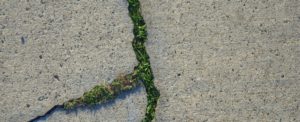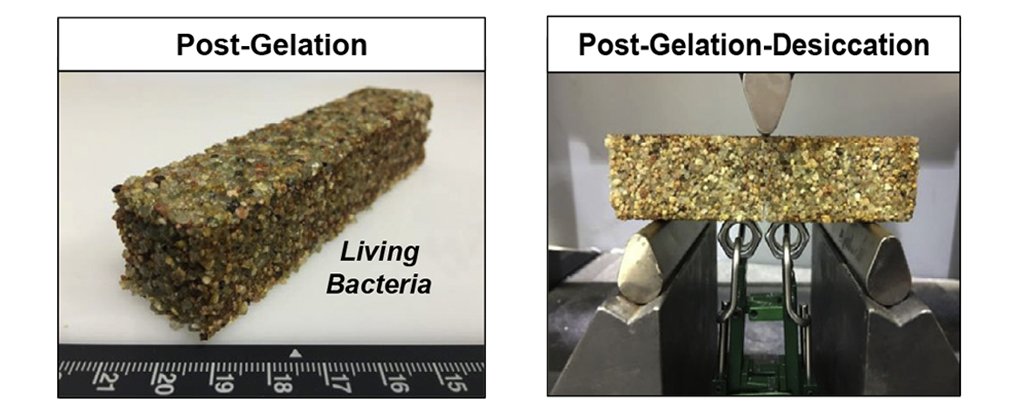Monday, January 20th, 2020
DAN ROBOTZSKI, - Science alert
Stephan: There are so many new technologies emerging whose foundational idea, is now the living matrix. The only non-authoritarian healthy way forward is to discard the dominant extractive profit model of society, for one that sees all life as interconnected and interdependent, with wellbeing at ever level as the first priority. Here is an example of what I mean.

Living concrete
Credit: Simon McGill/Getty
Scientists at the University of Colorado, Boulder have created what The New York Times calls a “living concrete”, teeming with photosynthetic bacteria, that can grow itself and regenerate itself – much like a living organism.
The concrete is a mixture of gelatin, sand, and cyanobacteria that cools similarly to Jell-O, the Times reports.
The resulting structure was able to regenerate itself three times after researchers cut it apart, suggesting a potential breakthrough in the nascent field of self-assembling materials.
Growing Back
The living concrete, which the Colorado scientists made in partnership with DARPA, starts out as a sickly green color that fades as the bacteria dies off, according to research published Wednesday in the journal Matter.
“It really does look like a Frankenstein material,” UC Boulder engineer and project leader Will Srubar told the NYT.
 (Heveran, etal., Matter, 2019)
(Heveran, etal., Matter, 2019)
Even as the color fades, the bacteria survive for several weeks and can be rejuvenated – resulting in further growth – under the right conditions.
Inhospitable Conditions
DARPA is particularly interested in a self-growing material that it can use to assemble structures in remote desert […]
1 Comment
Sunday, January 19th, 2020
Jay Alan Sekulow and Pat A. Cipollone, Counsels to the President - The White House
Stephan: Here is the case put forward by the Counsels for the President. As I read this, their basic argument is that Trump is above the law, and the Congress has no right to remove him; that the entire impeachment is just an attempt to overturn the results of the 2016 election. It is such a specious argument that I can hardly believe it is being put forward.
I have come to see this entire process as a turning point in American history. This impeachment is quite different than either the Nixon or Clinton cases. The basic argument of Trump and his supporters is that the presidency of the United States is above the law; it is the argument of authoritarians, who want to end democracy.
THE HONORABLE DONALD J . TRUMP, PRESIDENT OF THE UNITED STATES, HEREBY RESPONDS: The Articles of Impeachmentsubmitted by House Democrats are a dangerous attack on the right of the American people to freely choose their President. This is a brazen and unlawful attempt to overturn the results of the 2016 election and interfere with the 2020 election — now just months away. The highly partisan and reckless obsession with impeaching the President began the day he was inaugurated and continues to this day. The Articles of Impeachment are constitutionally invalid on their face. They fail to allege any crime or violation of law whatsoever , let alone high Crimes and Misdemeanors, as required by the Constitution. They are the result of a lawless process that violated basic due process and fundamental fairness. Nothing in these Articles could permit even beginning to consider removing a duly elected President or warrant nullifying an election and subverting the will of the American people. The ArticlesofImpeachmentnow before the Senate are an affront to the Constitution of the United States, our democratic institutions, and the American people. The Articles themselves— and the rigged process that brought them here — are a transparently political act by […]
No Comments
Sunday, January 19th, 2020
Ed Cara, - Centers for Disease Control and Prevention
Stephan: As a country, we are increasingly unhealthy. I think this is because as a nation we are increasingly depressed and anxious. But I also note, as you can see in the map below, that this unhealthiness is not spread equally across the country. As with so many other negative trends, the highest incidence of physical inactivity is in the deep south states. I think we need to face the fact that this is a cultural matter, and it is time to ask what is wrong with the culture of these states? Why are they are the bottom of everything, health, obesity, heart disease, education, incarceration, divorce? In every measure of a sick society, the deep south states lead the way. Why is that?
 New government research paints a dire picture of Americans and their exercise habits. Across all 50 states, at least 15 percent of adults reported being physically inactive, while in some areas of the country, nearly 50 percent of adults said they got no form of exercise.
New government research paints a dire picture of Americans and their exercise habits. Across all 50 states, at least 15 percent of adults reported being physically inactive, while in some areas of the country, nearly 50 percent of adults said they got no form of exercise.
The research is based on four years of survey data (2015-2018) collected by the Centers for Disease Control and Prevention and was published Thursday on the CDC’s website. The telephone-run survey asked people if they had participated “in any physical activities or exercises such as running, calisthenics, golf, gardening, or walking for exercise” in the past month, outside of any work duties. Those who said no were classified as inactive.
According to the CDC’s estimate, more than 15 percent of residents in every state or U.S. territory would be considered physically inactive. The percentage ranged from 17.3 percent of people living in Colorado to 47.7 percent living in Puerto Rico.
At least 30 percent of people living in […]
No Comments




 (Heveran, etal., Matter, 2019)
(Heveran, etal., Matter, 2019) New government research paints a dire picture of Americans and their exercise habits. Across all 50 states, at least 15 percent of adults reported being physically inactive, while in some areas of the country, nearly 50 percent of adults said they got no form of exercise.
New government research paints a dire picture of Americans and their exercise habits. Across all 50 states, at least 15 percent of adults reported being physically inactive, while in some areas of the country, nearly 50 percent of adults said they got no form of exercise.








